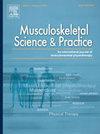The occurrence of cervicogenic headache: A mapping review
IF 2.2
3区 医学
Q1 REHABILITATION
引用次数: 0
Abstract
Background
Occurrence of cervicogenic headache (CeH), mostly expressed by estimates of the prevalence, ranges between 0.4% and 42%. However, transparency on such estimates is lacking, which hinders generalizing results.
Objective
Mapping the occurrence (expressed by incidence/prevalence) of CeH.
Design
Mapping review.
Method
A systematic literature search of PubMed, EMBASE, Web of Science, Scopus databases (last search update January 28th, 2025). The search query comprised terminology relating to “CeH”, “prevalence”, “incidence”.
Results
Thirty-four publications were included (prevalence n = 32, incidence n = 2). The prevalence of CeH varied depending on the geographical location (Norway: 0.17% - USA: 69%), population (age: 0.17%–56.7%, chronic headache: 0.17% - computer users: 64.5%), setting (inpatient: 13.8%–69%, outpatient: 0.38%–10%), diagnostic criteria (International Headache Society: 0.38%–40%, Cervicogenic Headache International Study Group: 0.17%–64.5%), and diagnostic process (questionnaires: 5.3%–64.5%, clinical examination: 0.17%–56.7%, diagnostic block: 0.17%–16.1%).
Conclusion
Most publications were retrieved from Europe, Asia, and the United States. One multicentre study provided results for the African continent. No conclusion could be drawn on the incidence of CeH. The populations studied (e.g., general, age-stratified, specific), settings (e.g., hospital, private practice, clinics, emergency services), diagnostic criteria (e.g., International Headache Society or Cervicogenic Headache International Study Group) and processes (e.g., questionnaires, clinical examination) were heterogeneous. Four publications required a diagnostic block in the diagnostic process. A standardized methodology, especially regarding the diagnostic criteria and process, is needed to compare studies, guarantee quality, and provide estimates to inform policy makers.
求助全文
约1分钟内获得全文
求助全文
来源期刊

Musculoskeletal Science and Practice
Health Professions-Physical Therapy, Sports Therapy and Rehabilitation
CiteScore
4.10
自引率
8.70%
发文量
152
审稿时长
48 days
期刊介绍:
Musculoskeletal Science & Practice, international journal of musculoskeletal physiotherapy, is a peer-reviewed international journal (previously Manual Therapy), publishing high quality original research, review and Masterclass articles that contribute to improving the clinical understanding of appropriate care processes for musculoskeletal disorders. The journal publishes articles that influence or add to the body of evidence on diagnostic and therapeutic processes, patient centered care, guidelines for musculoskeletal therapeutics and theoretical models that support developments in assessment, diagnosis, clinical reasoning and interventions.
 求助内容:
求助内容: 应助结果提醒方式:
应助结果提醒方式:


